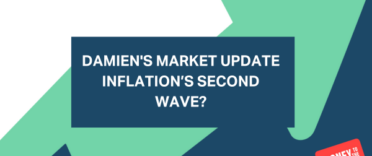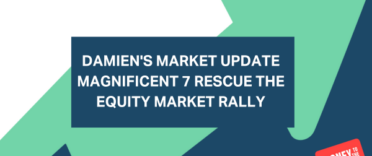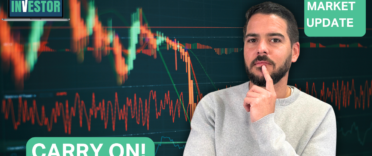Welcome to the latest episode of my monthly YouTube show where I discuss what is happening in investment markets and what to look out for. This month I talk about the latest trends that are impacting investment markets.
Each show lasts between 5-10 minutes and is aimed at DIY investors (including novices) seeking contemporary analysis to help them understand how investment markets work.
Subscribe to my YouTube channel to receive my weekly analysis of investment markets or alternatively, you can listen via my weekly Midweek Markets podcast below.
Damien's Market Updates monthly podcast
Other ways to watch, listen and subscribe
You can listen to other episodes and subscribe to the show by searching 'Money to the Masses' on Spotify or by using the following links:
Abridged transcript - Damien's Market Update - April 2023
Last month’s episode was titled “All possibilities still on the table”, but who would have thought that included a banking crisis?
In the hours after filming last month’s show inflation and economic growth took a back seat as a banking crisis came from out of left field. Equity markets slumped while gold and bonds rallied. But the worst of the equity market losses were felt at the epicentre of the crisis, which was bank stocks. Pick almost any bank stock in the US, UK or Europe and they were down somewhere between 10 and 20% in just a matter of days. Some fared even worse than that.
In episode 409 of the MTTM Podcast explained what triggered the failure of Silicon Valley Bank and ultimately the banking crisis, so I won’t go into detail here. But history has taught us that central banks, and in particular the US Federal Reserve, have a history of raising interest rates quickly until they eventually break something. The failure of Silicon Valley Bank, which was the largest bank failure in the US since the financial crisis in 2008, was a sign that the rapid rise in interest rates over the last year has indeed begun to break things. Interest rate rises have put pressure on banks' balance sheets, particularly regional US banks, at the same time that savers are moving their money in search of better returns. This sparked the series of bank runs we saw during March and the subsequent contagion to the UK and European banking sectors, resulting in the takeover of Credit Suisse by its Swiss rival UBS.
As US and European bank stocks tumbled they dragged the broader equity indices lower, while bonds rallied as recession risks began to resurface. The VIX (the market fear gauge) soared to 30 (its long term average being nearer 20) while the CNN Fear and Greed index hit “extreme fear” after signaling that greed was the emotion driving market behaviour just a month earlier. At the height of investor panic most stock market indices had given up all of their month to date gains to sit on losses of between 2% and 6%, with the bank-heavy FTSE 100 being the laggard.
Eventually emergency measures by central banks and governments (especially in the US) restored some calm to the beleaguered banking sector. One of the simplest ways to get a sense of the changing market sentiments towards bank stocks is to watch the price moves of an ETF (known as XLF) that tracks an index of S&P 500 financial stocks.
From a technical analysis point of view the damage caused during the initial two weeks of the banking crisis saw XLF fall to a critical technical analysis support line at 31. It's no coincidence that it hit a daily closing low of 31.01 before it rebounded. This support line (of 31) was a strong resistance line when the index peaked ahead of the covid crash. Zoom out further and the same is true of the financial crisis. In short, if XLF is below 31 it's not just bad news for banking stocks but the entire stock market in general and not just in the US. At the moment XLF sits at 32.88. But it’s still a far cry from 36, which was its level before the banking crisis erupted. It means there remains caution over the health of the banking sector even if a sense of calm has been restored and the headline equity market indices have recovered, with the exception of the FTSE 100 which is just shy of its early March level. By the way, if you want an index to watch that reflects sentiment towards European banks then keep an eye on the Stoxx Europe 600 Banks Index.
While there is now a sense that the banking crisis may be behind us (the VIX - the market fear gauge- has tumbled back to 17) and a full scale financial crisis has been averted but if March taught us anything it is that all possibilities still remain on the table.
During the worst of the banking crisis the best performing sector was Index-linked gilts. That shouldn’t come as a surprise as markets began pricing in that central banks would likely slow or cease their interest rate rises and begin cutting, possibly as early as late this year. It meant that bond funds with long durations rallied strongly. And Index-linked gilts tend to be long duration. Don’t forget that duration is a measure of sensitivity to interest rate moves. When we are talking about bonds, for every 1% increase or decrease in interest rates, a bond's price will change by roughly 1% in the opposite direction for every year of duration it has. So if a bond has a duration of 5 years then if the interest rate rises 1% the bond price will fall 5%. Bond funds own hundreds of bonds which when combined give the fund an overall duration which fund managers will look to control. During 2022, funds with longer duration fared the worst as central banks raised interest rates and markets priced in future rate hikes. That’s why gilt funds performed so badly in 2022, but so well since March this year.
In the equity space, technology funds can be described as being long duration. The price of technology stocks is influenced by the potential size of earnings and profits that will be realised in the future. Don’t forget, many technology companies are loss-making in their early years of existence. It means that share prices are a function of discounting (or repricing) those future earnings back to today. If future earnings are predicted to be higher, or more importantly interest rates drop, it means that the present value of those future earnings will be greater which therefore pushes up the company share price today. That is why technology stocks were the second best performing equity sector in March.
However, April has been different to March, with many equity market indices struggling for direction as investor sentiment has changed almost on a daily basis, influenced by the latest economic forecasts and analysts’ predictions of the future path of monetary policy. It means that Investors have flip-flopped from one asset or equity sector to the next, trying to buy into the latest narrative and so are in danger of chasing their own tails. One day renewed recession fears dictate market moves, only to be replaced by hawkish or dovish interpretations of central bank policy or statements. Then the next day inflation concerns preoccupy investors' minds. It’s resulted in assets rallying and falling in quick succession, but largely going nowhere.
But there are some trends that are worth watching in the coming weeks. Firstly the US dollar index has broken down and hovers just below the 102 level. If it breaks lower it could prove a tailwind for US equities and gold, the latter has rallied more than 10% since the banking crisis began on 8th March. Also the falling dollar has meant the pound has soared 5% in a little over a month.
However, it will surprise many to hear that European equities (as measured by the Stoxx Europe 600 index) are up over 23% in the last 6 months when taking into account currency moves. This is in stark contrast with the S&P 500 which is up just 2%, when you factor in the strengthening of the pound versus the dollar. It may also surprise some to hear that the French CAC 40 set a new all-time high in recent days as European stocks continue to benefit from China’s economic reopening post-Covid as well as the influx of investors tempted by attractive stock market valuations.
To sum up, the events of last month mean that investors are finally starting to take notice of assets that have been unloved over the last year - which includes gilts, bonds, gold, technology stocks and European stocks.



